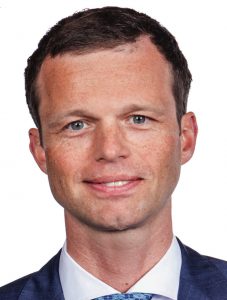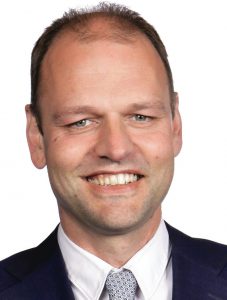Amsterdam, Netherlands-based Kempen Capital Management was established in 1991 and today manages €59.8 bn ($73 bn), of which €16.3 bn is in investment strategies and €43.5 bn in investment solutions. The firm has offices in Amsterdam, London, Edinburgh and Paris. The investment strategy is stable outperformance over the long term with ESG fully integrated into the investment process. Kempen’s investment strategies division has a number of equity strategies: small caps, high dividend, sustainable value creation and sustainable equity.
Mark Oud joined Kempen in 2017 as a senior portfolio manager for sustainable value creation. Before this he was a senior portfolio manager at Delta Lloyd Asset Management and head of Delta Lloyd’s Cyrte Investment. He previously worked at Main Capital Partners and Deutsche Bank.
Since August 2016, Richard Klijnstra has been head of sustainable value creation, having previously been head of Kempen’s credit team from 2006 to 2016. Prior to this, he worked at Fortis Investments in Paris and the Netherlands, and at Nationale-Nederlanden. Here he discusses Kempen’s approach to sustainable growth.
Are there any themes you favor?
We look at long-term drivers and currently there are three main groups: innovation, which includes mobility, artificial intelligence, cloud computing and industrial automation; people, which includes health and wellness, leisure and lifestyle; and planet, which includes clean energy – an important theme for future growth – and natural foods, given the trend toward healthier diets. For example, related to innovation we own Beazley, which is a leader in cyber-security. Long-term themes – particularly ESG-related – are important in our portfolio construction.
How would you describe your investment style?
We look for quality companies well positioned in industries that have room for sustainable growth. We are not value investors, although valuation is important to us. We use the Earnings Power Value model to evaluate investment opportunities, a framework we share with Kempen’s dividend team. We input growth and return on capital to the model and value that, too. If you look at our portfolio, we have a tilt to growth.
Do you confer with your colleagues? Could you own one stock across a number of strategies?
We do confer with colleagues and share meetings and ideas. There is full, open communication but all teams are responsible for their own individual portfolios. We could – and do – own stocks across a number of strategies so there is overlap between the portfolios.
Do you use a benchmark?
We use MSCI World and MSCI Europe as a reference but we have an active share ratio of around 90 percent.
Which screens do you use?
We use screening on an industry level. We look at long-term prospects and score, among others, expected industry growth, return on capital and development of market share, ESG and regulation. We look for the right companies within the industries we like.
Can you elaborate on your ESG focus?
Our ESG approach is best described as sustainable growth in a sustainable manner. ESG is an important part of our overall score when evaluating a company and we go a few steps further than other strategies. There are some industries we completely exclude because they don’t fit our approach. Examples are fossil fuels, all weapons and tobacco.
We use a best-in-class approach and only consider companies rated MSCI ‘BB’ or better. In assessing ESG, we use internal and external data. At the company level we look not only at negative, but also positive impacts. For example, we have a chemical company in our portfolio (Covestro) that has an innovative approach as it uses carbon instead of oil, reducing its usage of oil as a source material.
Do you have a market cap cut-off?
We generally look for companies with a minimum market cap of €1 bn.
What is your average turnover?
Portfolio turnover is between 10 percent and 20 percent as we are long-term shareholders and in general hold a stock for at least five years.
Do you prefer buybacks or dividends?
It doesn’t matter that much to us but paying a dividend can be a sign of a healthy capital discipline. On the other hand, we like companies that have room to invest in new opportunities in their business. If a stock is not overvalued, buybacks are fine, otherwise dividends.
In general, we prefer a company to invest money in profitable growth than to give it back to shareholders.
Do you have a target price in mind when you buy a stock?
We call it fair value. As we are long-term shareholders we don’t start selling once fair value has been reached. We look at the quality of a company first and the valuation second so we are willing to pay fair value for a good company long term.
What is your average position?
An average position is around 3 percent and our largest is 5 percent.
Is Corporate Governance important?
Yes, because it’s the ‘G’ in ESG so it’s taken into account in the total ESG score. What is particularly important to us is that we like to see long-term management incentives, not short-term ones. And by long term, we mean five years or more.
Can you discuss some of your holdings and why you bought them?
Valeo is a French car-parts manufacturer with a global presence. We like the trend toward electrification and autonomous driving and Valeo is well positioned compared with its peers in these two long-term opportunities. Within the car industry, there is also a long-term trend for original equipment manufacturers to outsource to suppliers. In addition, there are the electric vehicle and autonomous driving trends so suppliers can strengthen their value proposition.
Within any sector, there needs to be a long-term trend to enable long-term value creation. This enables companies to invest in new growth opportunities. So we have a positive view on the industry and, at the individual company level, Valeo is a strong, well- positioned operator with good returns.
Marine Harvest is a market leader in Norwegian seafood. Supply is limited and there are high barriers to entry as the industry is license-based and location- constrained because you can only farm in certain areas. Salmon (and seafood generally) is better positioned than meat because of the lower carbon footprint.
We are also invested in BlackRock and we like it for its clear trend toward passive investing – it is very well positioned in that area. The company also developed a market-leading tool for portfolio management called Aladdin that it sells to third parties.
Payment networks are an innovation theme we like because there is a trend for more digital payments. There are still a lot of cash and checks used, particularly in the US and emerging markets. We own both Visa and Mastercard, which are leaders and the strongest innovators with the biggest potential to benefit from this global trend.
On the small-cap side, we like cyber-security firm Beazley. We also like LHC Group, a US healthcare company that provides home-based care. It is well positioned to have more patients taken care of at home instead of at expensive hospitals.
Do you have to meet management before you buy a stock?
We like to but we don’t need to. We like to have a continuous dialog with companies so if we don’t see them before we buy, we make sure we see them in the months afterwards.
How do you prefer to meet management?
We prefer one-on-one meetings at our offices but if we need to travel, we will do. Site visits and capital market days are very helpful to us to better understand companies. We like to meet the highest level of management if possible – a CEO or CFO preferably. In the early stages of assessing a company we are happy to meet IR to build the relationship and get a better understanding of the business and the market. We also attend conferences and group meetings.
How has MiFID II affected you?
It has made it more difficult to meet a broad range of companies as there is a smaller supply of conferences for us. We now bear research costs on our own P&L, and we have a far shorter broker list than we used to – we use a maximum of 10 brokers whereas it used to be around 25. We reduced the number by looking at what we (and the other teams) needed and whether those investment banks provided short or longer-term research. We obviously favor longer-term research. Pricing can vary greatly, too, so this was also a factor. It’s been an extensive project: we now have three global brokers and a longer list of mostly regional specialists.
If we hear a company is coming to Amsterdam and we don’t have a relationship with its broker, we get in touch with the company directly. This obviously works best when you’re an existing holder and already have a relationship. We try to do this directly even if we don’t own the stock yet. Also, previously we asked brokers to set up conference calls for us but now we do this ourselves and go direct – it seems to work just as well.
Are there any conferences you particularly favor?
We’re still figuring things out – that’s the difficult part of MiFID II. The Nasdaq conference in London, which Mark attended in December 2017, is a great format. It’s an industry conference organized by an independent party but assisted by a broker.
Do you use independent research providers or expert networks?
Our aforementioned list of 10 includes independent research providers but not expert networks. Mark used expert networks at his previous firm and this is something the company is looking into.
Which companies do you find stand out in terms of IR practice?
Pharmaceutical company Novo Nordisk, insurer Allianz and Essilor, the ophthalmic specialist. And Valeo, which is responsive and has a broad IR team.
Why should corporates tarket Kempen?
If we are a shareholder or thinking of becoming one, we will be long-term partners. We look at a company’s strategic choices for the long term and on ESG-related issues. To have a critical dialog about the latter can be beneficial as we can share insight on what other companies are doing. If you know a company very well, you can have an interesting dialog about sustainable value creation rather than ask questions about tax rates or the next/last quarter. That’s the role we want to play.
A version of this article appeared in the IR Magazine


